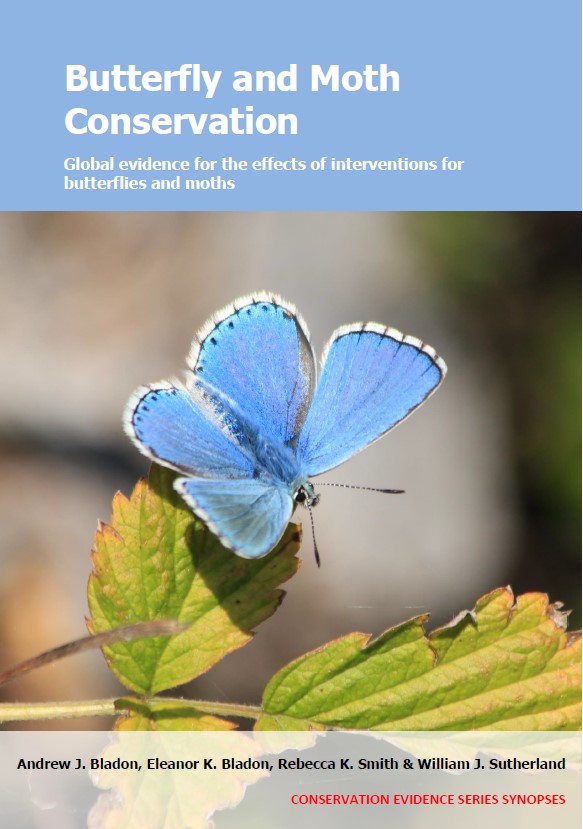Change mowing regime on grassland
-
Overall effectiveness category Awaiting assessment
-
Number of studies: 3
View assessment score
Hide assessment score
How is the evidence assessed?
-
Effectiveness
not assessed -
Certainty
not assessed -
Harms
not assessed
Study locations
Supporting evidence from individual studies
A replicated, site comparison study in 1992–1993 in 42 tall-grass prairies in Missouri, USA (Swengel 1996) found that prairie specialist butterflies were more abundant in hayed than burned prairies. In the year following haying, the abundance of prairie specialist butterflies (81 individuals/hour) was higher than two years after haying (68 individuals/hour), and both were higher than at sites the year after burning (2 individuals/hour), or two years after burning (21 individuals/hour). However, generalist and migrant species were less abundant at hayed sites (6–19 individuals/hour) than burned sites (18–24 individuals/hour). See paper for individual species results. Among 42 sites (6–571 ha), some were primarily managed by summer haying on a 1–2 year rotation with occasional cattle grazing, and some were managed by cool-season fire covering 5–99% of the site. In June 1992–1993, butterflies were surveyed at least once/year at most sites, either along a transect (35 sites) or from a single point (7 sites, recording only regal fritillary Speyeria idalia). Transects were sub-divided by the most recent management. Sixteen species observed >49 times and at >5 sites were included, and divided into “prairie specialists” (only found on prairies), “grassland species” (found in prairies and other grasslands), “generalists” (found in grasslands and other habitats) and “migrants” (only present in the study area during the growing season).
Study and other actions testedA replicated, paired, controlled study in 1993–1997 in nine oak savannas in Wisconsin, USA (King 2003) found that mowing grasslands in summer did not increase Karner blue butterfly Lycaeides melissa samuelis abundance compared to either burned or unmanaged grasslands. On three summer mown grasslands, the density of Karner blue (46–111 individuals/ha) was similar to three summer burned (36–213 individuals/ha) and three unmanaged (43–119 individuals/ha) grasslands. Nine restored oak savannas were burned on average every 3.5 years for 19–33 years prior to 1993. In winter 1993–1994, woody vegetation was removed with chainsaws on three grasslands, and these sites were then cut with a rotary mower in August 1994. In July 1994, three grasslands were burned. Three control grasslands received no mowing or burning. In July–August 1993–1997, butterflies were surveyed three times/grassland/year (>7 days apart) along transects placed 15 m apart.
Study and other actions testedA replicated, paired, controlled, before-and-after study in 2000–2002 in a coastal grassland in Essex, UK (Ringwood et al. 2004) found that mowing in August reduced the abundance of Fisher’s estuarine moth Gortyna borelii lunata caterpillars, but mowing in November and not mowing did not affect caterpillar numbers. One–two years after mowing in August, the number of hog’s fennel Peucedanum officinale plants showing signs of caterpillar feeding was lower than before mowing (0.26–0.29 fewer plants/m2). However, the number of plants with feeding signs after mowing in November was not significantly lower than before mowing (0.10–0.24 fewer plants/m2). In unmown areas, the number of plants with feeding signs was not significantly different one (0.04 fewer plants/m2) or two (0.10 more plants/m2) years after mowing at the other sites compared to before mowing. A grassland behind a sea wall was divided into three blocks, each sub-divided into three 84-m2 areas. In 2000–2002, areas were either mown with a tractor-drawn mower in late August, cut with a hand-held strimmer in November, or left unmown. Grass was cut to 10 cm with the cuttings left on site. No mowing had been conducted for >5 years prior to the experiment. In May–August 2000–2002, caterpillar feeding signs were recorded monthly on plants in two randomly-placed 1-m2 plots/treatment.
Study and other actions tested
Where has this evidence come from?
List of journals searched by synopsis
All the journals searched for all synopses
This Action forms part of the Action Synopsis:
Butterfly and Moth Conservation
Butterfly and Moth Conservation - Published 2023
Butterfly and Moth Synopsis





)_2023.JPG)














